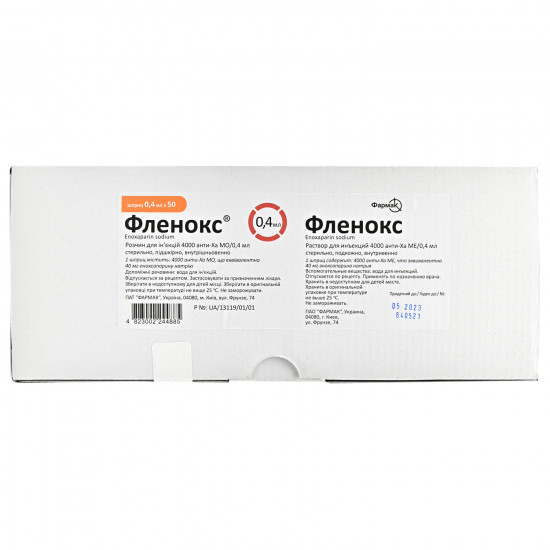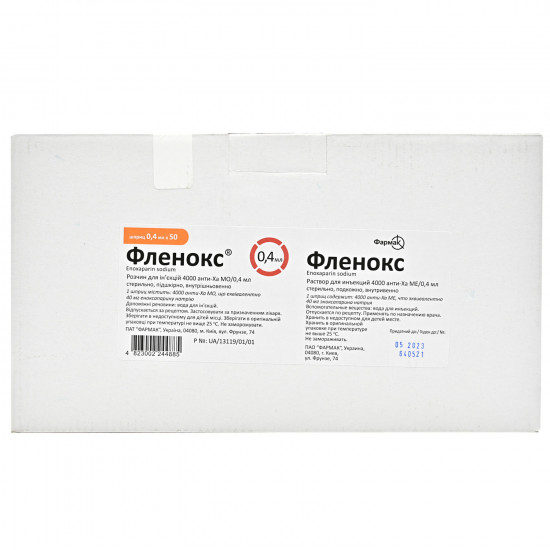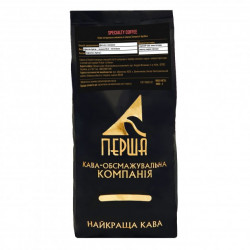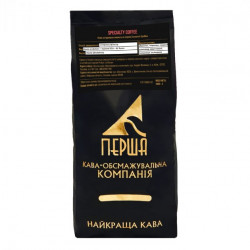



- Stock: In Stock
- Model: 184835
0% Customers recommend this product
-
5 Awesome0%
-
4 Great0%
-
3 Average0%
-
2 Bad0%
-
1 Poor0%
Reviews Over Flenoks solution for infection. 4000 Anti-ha ME/0.4ml syringe of 0.4 ml No. 50
- (0)
Total Reviews (0)
click here write review to add review for this product.
Report this review.
Description
Solution is applied to injections of Flenoks at the following indications:
- prevention of a venous thrombembolia at surgical interventions which are followed by moderate and high thrombogenic risk;
- prevention of a deep vein thrombosis at the patients who are on a bed rest in connection with acute therapeutic diseases: heart failure ІІІ or class ІV on classification NYHA, acute respiratory insufficiency, an acute infectious or rheumatic disease, with at least one more risk factor of a venous thrombembolia;
- prevention of a thrombogenesis in an extracorporal contour of blood circulation during a hemodialysis (the procedure on average lasts approximately till 4 o'clock);
- treatment of the diagnosed deep vein thrombosis which is followed or is not followed by a pulmonary embolism and has no heavy clinical symptoms, except for a pulmonary embolism which demands treatment by thrombolytic means or surgical intervention;
- treatment of unstable stenocardia and acute myocardial infarction without Q tooth in a combination with acetylsalicylic acid;
- treatment of an acute myocardial infarction with rise / elevatsiyey ST segment in a combination with thrombolytic means at patients, which perhaps further use of coronary angioplasty and also at patients to whom this procedure is not carried out.
Structure
Active ingredient: enoksaparin sodium;
contains1 ml of solution: 10000 Anti-ha ME that is equivalent to 100 mg of an enoksaparin of sodium;
4000 Anti-ha ml ME/0.4 that is equivalent an enoksaparina of sodium of 40 mg;
Excipient: water for injections.
Contraindication
- hypersensitivity to an enoksaparin, heparin or its derivatives, including other low-molecular heparins;
- existence in the anamnesis heavy the II heparin-the induced thrombocytopenia (HIT) which was caused by not fractional heparin or low-molecular heparin;
- bleeding or the tendency to bleeding connected with disturbance of a hemostasis (disseminate intravascular fibrillation can be a possible exception of this contraindication if it is not connected with a geparinoterapiya;
- organic lesions which can cause bleeding;
- active clinically significant bleeding;
- usually is not recommended to appoint medicament in preventive doses to patients aged from 65 years in combination with the following medicines: acetylsalicylic acid in anesthetics, febrifugal and anti-inflammatory doses; non-steroidal anti-inflammatory medicaments (NPVP) (system use); "Dextran 40" (parenteral use);
- intracerebral bleeding;
- active ulcer of stomach or duodenum;
- due to the lack of the relevant data medicament is not used to patients with a heavy renal failure (the clearance of creatinine calculated by a formula Kokrofta, 30 ml/minute), except for the patients who are on dialysis; patients with a heavy renal failure should appoint unfractionated heparin (for carrying out calculation for a formula Kokrofta it is necessary to have data of the last measurement of body weight of the patient;
- spinal or epidural anesthesia should not be applied at all to patients who are on treatment by low-molecular heparins (NMG); to the patients receiving heparin for treatment, but not for prevention local anesthesia at planned surgical interventions is contraindicated to
- ;
- in an acute extensive ischemic stroke of a brain with a loss of consciousness or without (if the stroke is caused by an embolism, in the first 72 hours after a stroke enoksaparin it is impossible to apply); by
- did not determine efficiency of medical doses of NMG, irrespective of the reason, extensiveness of defeat or weight of clinical manifestations of a heart attack of a brain today;
- in an acute infectious endocarditis (except some heart diseases caused by an embolism);
- in a renal failure of light or moderate severity (clearance of creatinine of 30-60 ml/minute).
Route of administration
1 mg (0.01 ml) of an enoksaparin of sodium corresponds to about 100 activity units Anti-ha of ME. Flenoks it is necessary to enter subcutaneously at preventive and medical use, except for the following cases: use of medicament for anti-coagulation in practice of a hemodialysis; treatment of patients with a myocardial infarction with an elevation of a segment of ST which need intravenous bolyusny administration.
Flenoks is not allowed to be entered intramusculary. Drug is recommended for use only to adult patients.
Technician of hypodermic introduction. The syringes filled with the producer are ready to direct use. If necessary the dose of the medicament Flenoks can be corrected depending on the body weight of the patient. For this purpose in case of need before carrying out an injection it is necessary to remove excess amount of medicament from the syringe. If at a distance excess amount of medicament there is no need, then in order to avoid loss of medicament it is not necessary to eliminate air bubbles from the syringe before an injection. It is better to carry out a subcutaneous injection of the medicament Flenoks when the patient is in a prone position. To administer the medicament in hypodermic fatty tissue of a perednebokovy or posterolateral surface of an abdominal wall serially in the right and left side, using different places for each injection. The needle needs to be entered at full length vertically into skin fold thickness, but not at an angle to it which was formed between big and index fingers. The fold of skin needs to be held throughout all introduction of an injection. It is impossible to rub the place of an injection after introduction.
Technician of intravenous (bolyusny) administration / use of the medicament Flenoks for treatment of an acute myocardial infarction with raising of a segment of ST. Treatment is begun with an intravenous bolyusny injection then carry immediately out a subcutaneous injection. Mixing or simultaneous administration of medicament with other medicines is not allowed. For elimination of residues of other medicines and therefore, for prevention of their mixing with the medicament Flenoks before carrying out an intravenous bolyusny injection of the medicament Flenoks and after it a system it is necessary to wash out enough 0.9% of solution of sodium of chloride or 5% of solution of glucose. Flenoks it is possible to enter safely into 0.9% solution of sodium of chloride or into 5% glucose solution.
Feature of use
Pregnant
as a precautionary measure, enoksaparin in medical doses usually it is not necessary to appoint during pregnancy. It is impossible to carry out spinal or epidural anesthesia at the patients receiving therapy of NMG in medical doses at all.
Childrendue to the lack of the relevant data does not recommend to apply
NMG in pediatric practice. Drivers
Administration of medicament does not affect ability to run the vehicle and to work with other mechanisms. However it is necessary to be careful, considering possible side reactions.
OverdoseAccidental overdose at hypodermic introduction of considerable doses of NMG can lead
to emergence of hemorrhagic complications. In case of bleeding of some patients it is possible to treat protamin sulfate, at the same time it is necessary to consider that: the efficiency of protamin of sulfate is much lower, than efficiency which is observed at overdose of not fractional heparin; before sulfate protamin use because of possibility of the undesirable phenomena (in particular an acute anaphylaxis) it is necessary to weigh carefully a ratio advantage/risk. Neutralization of an enoksaparin to carry out
by slow intravenous administration of protamin (sulfate or a hydrochloride).
These recommendations are intended tofor patients with normal function of kidneys which receive repeated doses of drug. However completely it is impossible to neutralize Anti-ha activity of an enoksaparin. Besides, neutralization can be temporary owing to features of pharmacokinetics of absorption of NMG therefore there can be a need to distribute the general calculated protamin dose on several injections (2-4) which to enter within 24 hours.
At hit of low-molecular heparin in a stomach, even in large numbers, heavy complications are improbable (such cases were not registered) owing to insignificant absorption of medicine in a stomach and intestines.
Side effects
In clinical trials of bleeding were side reactions about which reported most often. Here also serious bleedings about which reported at 4.2% of patients (surgical profile) belong. Some of these cases were lethal.
Interaction
Undesirable combinations
With acetylsalicylic acid in anesthetics, febrifugal and anti-inflammatory doses (and by analogy other salicylates). The risk of bleeding increases (oppression of function of thrombocytes and damage of a mucous membrane of digestive tract under the influence of salicylates). It is necessary to apply the febrifugal anesthetics which are not relating to salicylates (for example paracetamol).
S NPVP, including ketorolak (system use). The risk of bleeding increases (oppression of function of thrombocytes and damage of a mucous membrane of digestive tract under the influence of NPVP). If it is impossible to avoid simultaneous use, it is necessary to carry out careful clinical supervision.
With a dextran 40 (parenteral use). The increased risk of developing bleeding (oppression by a dextran of the 40th function of thrombocytes).
Z other trombolitika (for example, alteplazy, reteplazy, streptokinase, tenekteplazy, urokinase) and anticoagulants.
Storage conditionsto Store
in original packing at a temperature not above 25 °C, out of children's reach. Not to freeze.
Expiration date - 2 years.
Specifications
| Characteristics | |
| Active ingredients | Enoksaparin |
| Amount of active ingredient | 10000 Anti-ha ME/ml |
| Applicant | Pharmak |
| Code of automatic telephone exchange | B01AB05 Enoksaparin |
| Interaction with food | It doesn't matter |
| Light sensitivity | Not sensitive |
| Market status | The branded generic |
| Origin | Biological |
| Prescription status | According to the prescription |
| Primary packing | syringe |
| Producer | PUBLIC JOINT STOCK COMPANY PHARMAK |
| Quantity in packing | 50 syringes |
| Release form | solution for injections |
| Route of administration | Hypodermic |
| Sign | Domestic |
| Storage temperature | from 5 °C to 25 °C |
| Trade name | Flenoks |




















